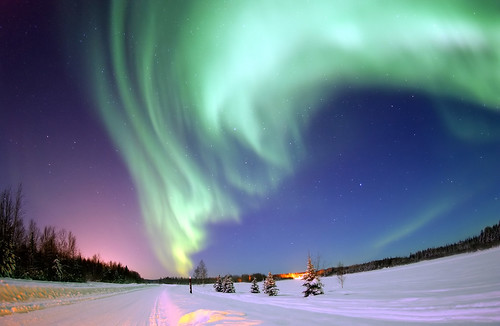It is said that if you experience this, then you one of the lucky few people in the world.Though this magical phenomenon happens like 10 times an year in the northern regions. It is so unpredictable that the people that actually see it are stunned by its charm, and get addicted to watching it again and again.Look out for it during September-March!
 WHAT IS AURORA BOREALIS?
WHAT IS AURORA BOREALIS?
The name 'Aurora Borealis' is Latin and aptly describes the phenomenon that is the Aurora Borealis! A basic definition of Aurora Borealis is luminous arches or streams of light which appear in the in Northern regions of the earth. The Latin words 'Aurora Borealis' are roughly translated as ' Northern Lights' - hence the alternative name! Aurora pertains to the lights ( the red dawn ) and Borealis pertains to the North. The term Aurora Borealis was named by the Italian scientist Galileo Galilei (1564-1642). It is interesting to note that 'Aurora' was the name given to the Roman goddess of dawn.
 WHAT IS AURORA BOREALIS?
WHAT IS AURORA BOREALIS?The name 'Aurora Borealis' is Latin and aptly describes the phenomenon that is the Aurora Borealis! A basic definition of Aurora Borealis is luminous arches or streams of light which appear in the in Northern regions of the earth. The Latin words 'Aurora Borealis' are roughly translated as ' Northern Lights' - hence the alternative name! Aurora pertains to the lights ( the red dawn ) and Borealis pertains to the North. The term Aurora Borealis was named by the Italian scientist Galileo Galilei (1564-1642). It is interesting to note that 'Aurora' was the name given to the Roman goddess of dawn.
The Legends and Myths surrounding Aurora Borealis
Long ago the appearance of the Aurora Borealis, or the Northern Lights caused a range of emotions in the people who witnessed then - alarm, fear, wonder, dread and excitement to name but a few! People did not understand what caused these amazing spectacles of lights in the sky. The phenomena of the Northern Lights were explained by different stories - the legend and myth of bygone days:
Long ago the appearance of the Aurora Borealis, or the Northern Lights caused a range of emotions in the people who witnessed then - alarm, fear, wonder, dread and excitement to name but a few! People did not understand what caused these amazing spectacles of lights in the sky. The phenomena of the Northern Lights were explained by different stories - the legend and myth of bygone days:
- The lights were God or Goddesses appearing to mortals
- The lights were spirits or souls dancing in the sky
- The red colour was associated with legend or myths relating to blood - murder, death, armies, wars and suicide
WHERE TO XPERIENCE!!!Contrary to intuition, seeing the Northern Lights isn't just a matter of heading "north." The Lights usually circle the globe in a circular or elliptical band centered on the earth's North Magnetic Pole, which is not at the same location as the North Geographic Pole, but rather is offset in the direction of northern Canada. Furthermore, auroral displays aren't strongest at the North Magnetic Pole; the band of greatest auroral activity is usually offset from the Magnetic Pole by 20 degrees or so.This quirk is actually fairly convenient for would-be aurora watchers. It means that locations in the north-central United States, for example Minnesota and North Dakota, and also southern Canada see Northern Lights much more frequently than they would if the Lights were centered on the North Geographic Pole. Alaska and Lapland (the northern part of Finland, Norway and Sweden) also fall in the region of greatest probability, while the far-north territory of Siberia that misses out on some of the Lights (because the Magnetic Pole is displaced away from that region) tends to be more inaccessible to the traveler.A curiosity is that the exact location of the North Magnetic Pole varies from year to year, sometimes by tens of miles. The Pole has been moving north for a few years now as of 2006; it's now near Ellesmere Island in the nearly uninhabited far north of Canada. As a consequence, the advantages of being on the "right side" of the earth are not as pronounced as they were some years ago. Still, there's a slight North American bias even today in your chance of seeing the Lights.This said, the actual latitudes of the Lights vary considerably. In times of high solar activity (more on that later), the Lights may be seen in North America at latitudes as low as 35 degrees north, meaning that all but the southernmost parts of the United States may get a display. The offset of the Pole keeps solar storms from benefiting Europe quite as strongly, but most of the countries of northern Europe will get displays during periods of solar storms.

i could only dream of seeing the northern lights. i'm from the southern hem, in the Philippines, and there is no way i can witness such phenomenon. :(
ReplyDelete